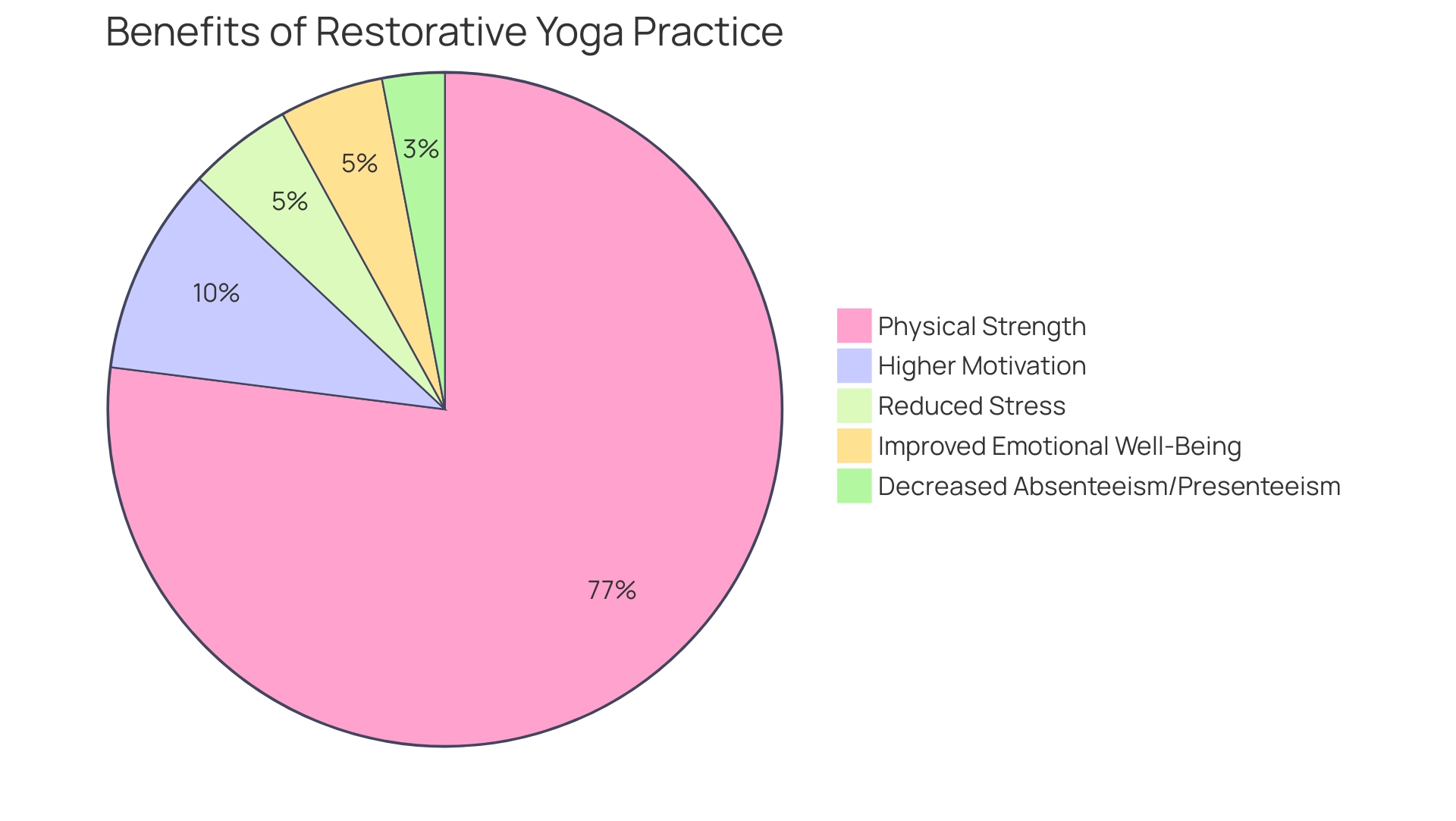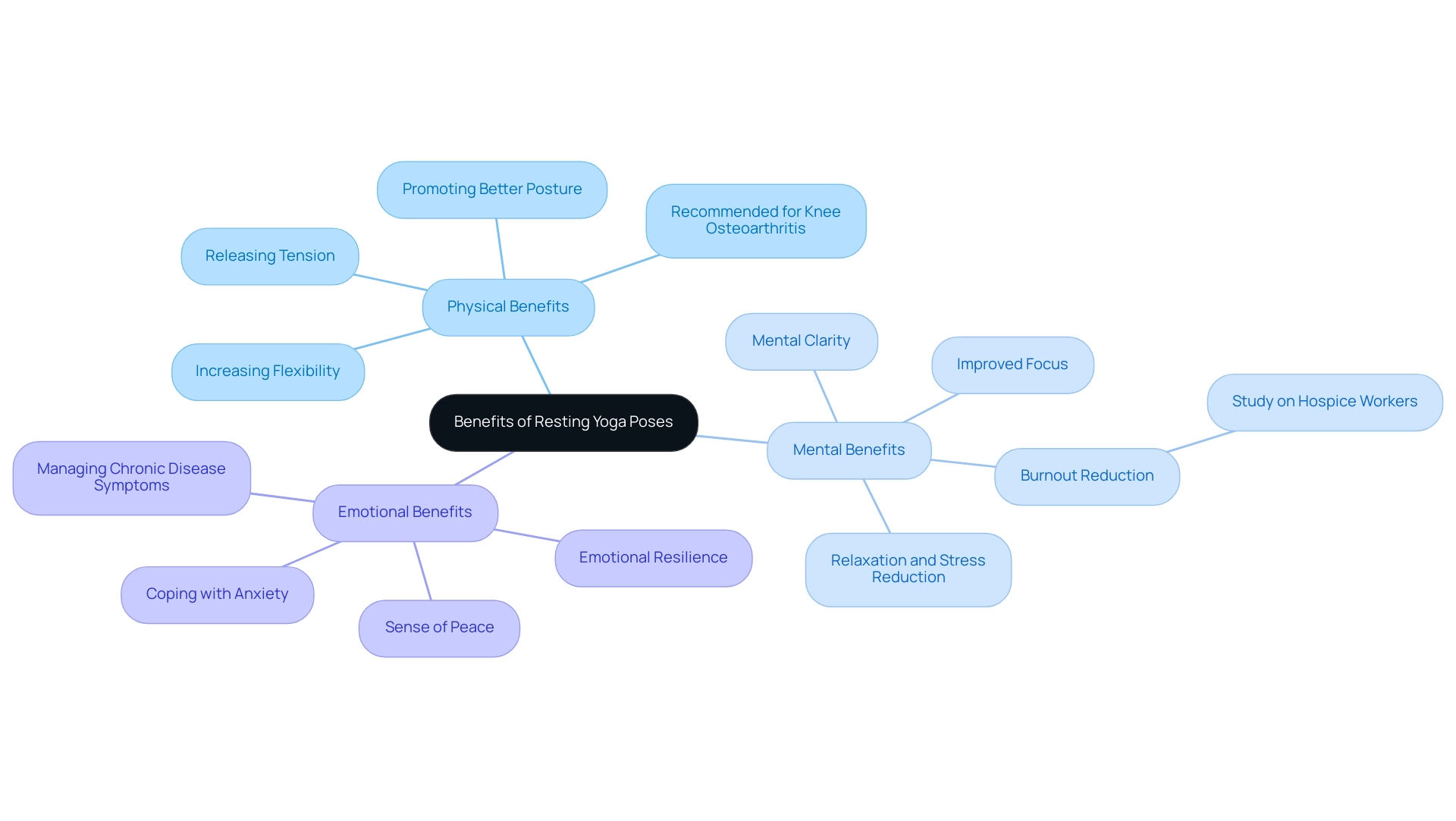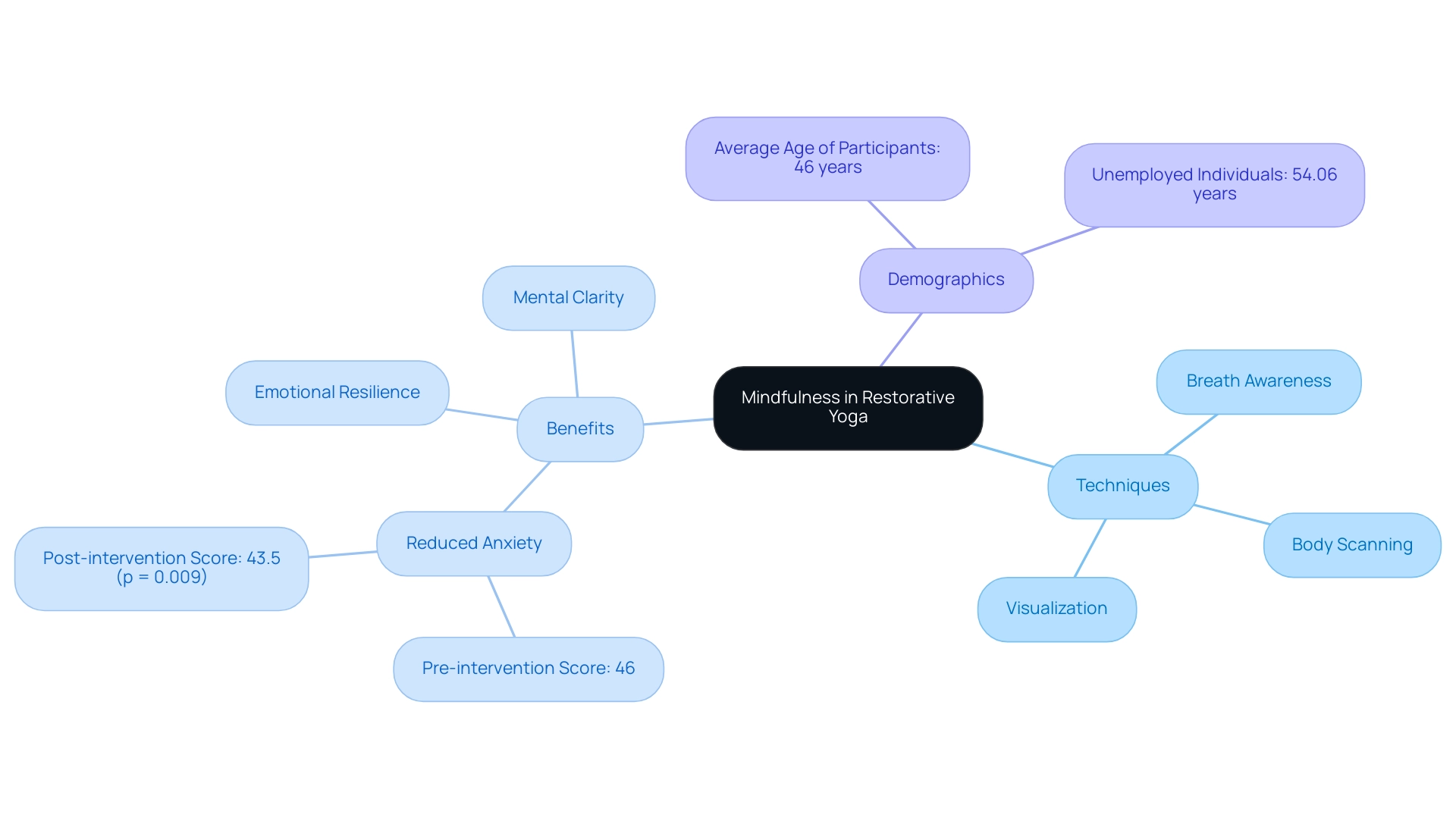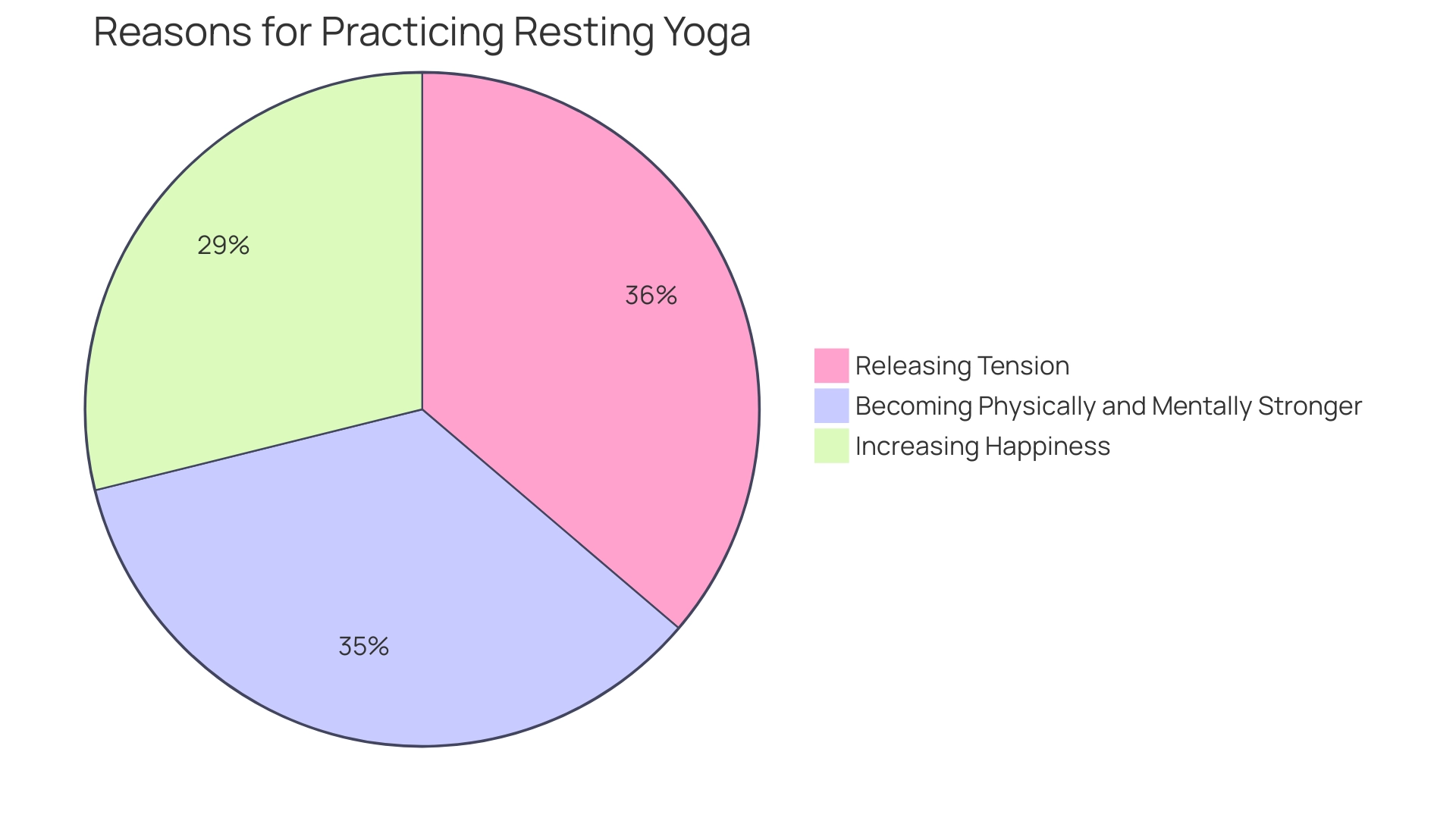Overview
Resting yoga poses are gentle restorative exercises that prioritize relaxation and healing, offering numerous physical, mental, and emotional benefits. The article highlights that these poses, supported by props for comfort, not only help release tension and improve flexibility but also enhance mental clarity and emotional resilience, making them essential for overall well-being in today's fast-paced environment.
Introduction
In a world that never seems to slow down, the importance of finding moments of peace and rejuvenation cannot be overstated. Restorative yoga, with its gentle and nurturing approach, offers a sanctuary for individuals seeking to reclaim their well-being amidst the chaos of daily life. By incorporating supported poses and mindfulness techniques, this practice not only alleviates physical tension but also cultivates emotional resilience and mental clarity.
As organizations increasingly recognize the value of employee wellness, integrating restorative yoga into workplace initiatives can foster a culture of care that enhances motivation and engagement. This article delves into the transformative power of restorative yoga, exploring its benefits, essential poses, and the optimal environments for practice, ultimately empowering teams to thrive in both body and mind.
Understanding Restorative Yoga: A Foundation for Resting Poses
The resting yoga pose is a gentle yet transformative restorative exercise that prioritizes relaxation and healing, making it an essential component of any wellness routine. Unlike more active forms of this practice, restorative sessions invite practitioners to restore balance and rejuvenate both body and mind through a series of poses, including the resting yoga pose. This practice employs props such as blankets, bolsters, and blocks, creating a cocoon of comfort that facilitates deep relaxation.
Recent studies, including those published in the journal 'Preventive Medicine,' have shown that:
- 77% of participants reported feeling physically stronger after incorporating this practice into their routines, highlighting its holistic benefits.
- Research from 'Workplace Health & Safety' indicates that employees who engage in regular exercise, including stretching, report higher motivation levels, reduced stress, and improved emotional well-being, leading to enhanced workplace performance.
- These studies also highlight that exercise initiatives can greatly decrease absenteeism and presenteeism, making rejuvenating practices a potent remedy for stress and fatigue.
By promoting a state of rest and recovery, the resting yoga pose in restorative practice is especially advantageous for individuals facing the challenges of today's fast-paced world. Additionally, the average hourly wage for instructors of this practice is $30.46, providing a financial perspective for HR Benefits Managers considering the implementation of such programs. The increasing popularity of this practice, particularly during the COVID-19 pandemic, is demonstrated by a notable rise in influencer accounts within the wellness space, as mentioned by HypeAuditor.
Integrating resting yoga poses into your wellness initiatives not only nurtures individual well-being but also fosters a culture of care and mindfulness within your team, ultimately driving motivation and engagement.

The Benefits of Resting Yoga Poses: Enhancing Mind and Body
A resting yoga pose offers numerous advantages that go beyond the mat, making it an effective means for improving overall well-being. On a physical level, a resting yoga pose is instrumental in:
- Releasing tension throughout the body
- Increasing flexibility
- Promoting better posture
These are crucial elements for anyone aiming to maintain physical health. The American College of Rheumatology and the Arthritis Foundation conditionally recommend practicing specific exercises for individuals with knee osteoarthritis, underscoring its potential benefits for chronic conditions.
Mentally, a resting yoga pose serves as a sanctuary for relaxation and stress reduction; studies indicate that engaging in these practices can lead to improved focus and mental clarity. Emotionally, restorative practices like the resting yoga pose nurture a profound sense of peace and emotional resilience, providing individuals with effective strategies to cope with anxiety and emotional fatigue.
Significantly, a 2021 study centered on hospice workers during the COVID-19 pandemic demonstrated that yoga-based meditation interventions greatly alleviated burnout, highlighting how these exercises assist individuals in becoming more attuned to their bodies, ultimately reducing stress.
There is promising evidence that this practice may help individuals with chronic diseases manage symptoms and improve quality of life. By incorporating a resting yoga pose along with restorative stretches into a daily routine, individuals can greatly improve their health and productivity, making this activity an essential part of any wellness regimen. Embracing these healing practices can empower teams to thrive both personally and professionally.

Key Techniques: Exploring Essential Resting Yoga Poses
Incorporating essential resting yoga poses, including Child’s Position, Supported Bridge Position, and Legs-Up-the-Wall Position, into your routine can profoundly impact well-being.
- Child’s Pose is particularly effective for promoting deep relaxation while gently stretching the back and hips, making it an ideal choice for unwinding after a long day.
- Supported Bridge Pose not only opens the chest and heart but also alleviates tension in the lower back, offering a soothing release for those who spend extended hours seated.
- Legs-Up-the-Wall Pose stands out for its ability to reduce fatigue and enhance circulation, providing a refreshing boost to your energy levels.
Each of these resting yoga poses can be held for several minutes, allowing the body to fully relax and absorb their restorative benefits. Regular practice of the resting yoga pose can enhance physical comfort and mental clarity, creating a strong foundation for overall wellness.
A systematic review published in the Cochrane Database of Systematic Reviews in 2022 highlights the positive effects of this practice on chronic non-specific low back pain, emphasizing its role in improving physical health. Additionally, studies show that this practice can improve sleep patterns and enhance overall well-being, contributing to a higher quality of life. For instance, a case study examining the benefits of a mind-body practice for individuals living with HIV/AIDS revealed significant positive effects on health and well-being in that population.
As Howard E. LeWine, MD, states,
Mindfulness refers to focusing your attention on what you are experiencing in the present moment without judging yourself.
By incorporating these practices into your daily routine, you foster a mindful approach to well-being that can motivate your team to follow suit.

Mindfulness in Restorative Yoga: Cultivating Awareness and Relaxation
Mindfulness is a cornerstone of rejuvenating yoga, empowering practitioners to develop a heightened awareness of their bodies and breath. This focus on the present moment not only facilitates deeper relaxation but also magnifies the benefits of practicing a resting yoga pose. Effective techniques such as breath awareness, body scanning, and visualization serve to cultivate a profound sense of calm and mental clarity during sessions.
Recent findings indicate that these mindfulness techniques can significantly reduce anxiety levels; for instance, a study revealed that the pre intervention trait anxiety score decreased from 46 to 43.5 post-practice, showcasing a notable improvement (p = 0.009). Alongside these findings, a 2017 review of 15 studies on mindfulness-based techniques found them effective for managing eating behaviors, emphasizing the wider applications of mindfulness in everyday life. As David Shurtleff, Ph.D., states, embracing such approaches can lead to enhanced emotional resilience and mental clarity.
Furthermore, comprehending the demographic context is crucial; for example, the average age of participants in related studies was 46 years, with unemployed individuals averaging 54.06 years, indicating a diverse range of individuals gaining from these methods. By incorporating mindfulness into rejuvenating exercise routines, individuals can unlock not only physical benefits but also a strengthened ability to handle stress and emotional challenges, making it an essential aspect for anyone looking to improve their well-being.

Creating the Perfect Environment for Resting Yoga Practice
Creating an optimal setting for a resting yoga pose is essential for enhancing relaxation and overall well-being. A quiet, comfortable space free from distractions is essential. Consider dim lighting, calming scents from essential oils, and soothing music to cultivate a serene atmosphere that invites tranquility.
Reasons for practicing this discipline include:
- Releasing tension (54%)
- Becoming physically and mentally stronger (52%)
- Increasing happiness (43%)
This highlights the importance of a calming environment in achieving these benefits. According to a Harvard study, 60% of participants in hot yoga sessions experienced a significant decrease in depression symptoms, reinforcing the mental health advantages associated with a well-structured yoga space. Utilizing props such as cushions, blankets, and bolsters not only offers additional comfort but also supports various poses, including the resting yoga pose, thus making the activity more restorative.
Consistency in practice time reinforces the habit and deepens engagement. As Rishikesh Yogkulam aptly states,
Rishikesh Yogkulam exists to bring the authentic teachings of this practice back to this discipline; both on and off the mat.
Furthermore, yoga business owners can enhance client engagement through effective management tools like Exercise.com, which is highlighted as the best yoga business management software, streamlining operations for a better client experience.
By fostering an environment that prioritizes comfort and intention, individuals can unlock the profound benefits of the resting yoga pose, paving the way for enhanced mental and physical health.

Conclusion
Incorporating restorative yoga into daily routines offers a multitude of benefits that extend beyond the yoga mat. This gentle practice not only promotes relaxation but also actively reduces physical tension, enhances emotional resilience, and fosters mental clarity. Supported poses like Child’s Pose, Supported Bridge Pose, and Legs-Up-the-Wall Pose serve as effective tools for alleviating stress and rejuvenating both body and mind, making them essential components of a holistic wellness strategy.
The integration of mindfulness techniques within restorative yoga elevates the practice, allowing individuals to cultivate a deeper awareness of their bodies and breath. This intentional focus not only enhances the benefits of the poses but also contributes to improved emotional health and reduced anxiety levels. Creating an optimal environment for practice—characterized by comfort, tranquility, and minimal distractions—further amplifies these positive effects, fostering a culture of care that can resonate throughout teams and organizations.
As the world continues to move at a relentless pace, prioritizing well-being through restorative yoga can lead to significant improvements in motivation, engagement, and overall workplace performance. By championing this practice, organizations can empower their employees to thrive, ultimately enhancing both personal and professional lives. The time to embrace restorative yoga is now; it is a powerful pathway to cultivating a healthier, more resilient workforce.




